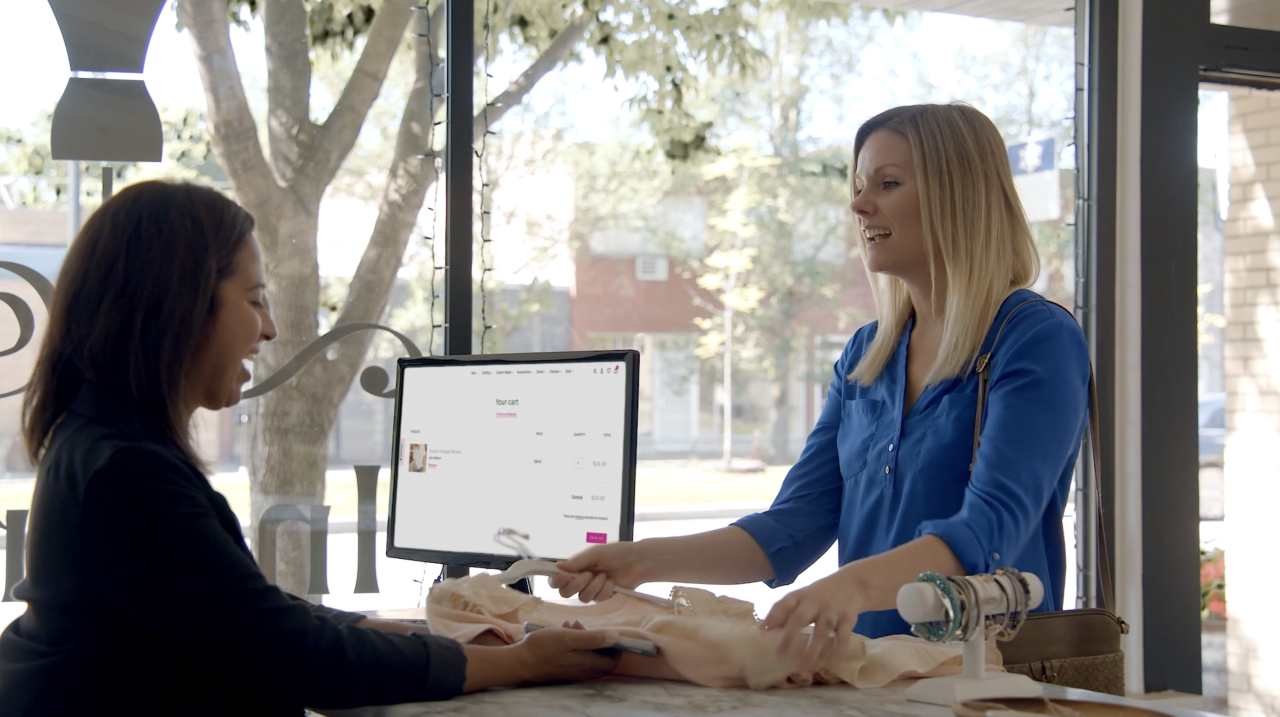
Pulling off successful productions in the time of Covid 19
Last month, we were all ready to shoot a video for our client Zebra Technologies in a boutique clothing store. They provide the handheld scanners that help retail businesses track inventory. Our video intended to show them in action, on site with customers. Easy enough, right? Not under COVID.
It’s clear that COVID 19 has forever changed the way productions will run. For us last month, that meant a smaller crew on set to reduce risk. It meant wearing masks and avoiding huddling together. It meant that, due to COVID precautions, the Creative Director and Client Lead were unable to attend the shoot live – requiring a need to patch them in remotely via a Zoom link. And, of course, we also had to deal with the standard production snafus that are bound to come up from time to time: we lost our location 48 hours before the shoot, causing us to scramble to find a new boutique AND a massive storm decided to roll though the area the night before the shoot, knocking out the power for the day.
Storms aside, these challenges are going to become commonplace going forward and how we react and adjust will be the difference between a successful shoot and one that falls apart. Here were three things we did that enabled us to take these COVID curveballs and still hit it out of the park.
1. Start with a solid plan
With reduced crew and key players patching in remotely, it’s more important than ever to get on the same page long before you set foot on set.
Align on creative vision – In our case, COVID precautions meant our Creative Director wasn’t able to go on the shoot. While he was able to patch in via a Zoom link and see what was being captured on camera, communicating feedback and direction to the set was tricky. So it was vital that the original creative vision be fully understood by agency stand-ins on set.
Have a tight plan for shooting – Well-scouted set ups, wardrobe choices, desired angles. Knowing what you’re looking for before you see it becomes more important than ever. Delays are going to happen, so you might find less time to “try stuff” on set than what you’re used to. Planning ahead is key to buying back some of that precious time.
2. Be nimble and open-minded
Complications are going to arise. People are going to lose their cool. Here’s a couple ways to reduce the chaos.
Wear lots of hats – With less people, there’s going to be more to do. It’s important to work with crews that are multi-faceted. And keep your ears open for ways you can jump in to help.
Exercise patience – Though it may sound attractive to have a client out of your hair (and instead be just a faint voice on a Zoom call), it can be more nerve-racking than having them right over your shoulder. Being remote can cause a sense of powerlessness. And that can lead to anxiety, over-thinking and meddling. Be patient. Make sure clients and other stakeholders feel like they’re being heard and understand what’s going on. Let the director know going in that there will be delays throughout the day. Cool heads keep things moving.
3. Set up clear communication channels
As previously mentioned, patching in remotely can cause extra tension. To keep your client and crew sane, it’s important to keep a couple things in mind.
Have one voice communicating feedback from your remote link – It’s hard enough for directors to focus on shots with Creative Directors and crew in their ear. Now with a new set of voices patching in, it’s important to choose one person to filter and communicate feedback from the remote link to set.
Reduce the amount of voices on your remote link – People love the convenience of being able to “attend the shoot” from wherever they may be in the world. And they also love to give their opinion. It’s important to agree in advance on who will be allowed to offer feedback. Too many voices can not only compromise the quality of the work, it can cause complete gridlock on set.
With all the new twists and turns happening on productions, one thing is certain: the changes are here to stay. And believe it or not, that’s a good thing. Smaller crews and more people patching in means more flexibility when it comes to planning and attending shoots. Also, more visibility into the productions can be a positive. More people “experiencing” the shoot will ultimately lead to more widespread buy-in from clients and stakeholders. So, who will wind up with successful shoots going forward? It will be those who merge solid planning, multi-faceted staff and a roll-with-the-punches attitude. As the state of production changes, are you and your team ready?

Freelance Senior Copywriter/B2B B2C/Chicago expat/brand dev./digital everything/video scripting/naming
3yGreat insights!
Let's have some fun thinking big together.
3yNicely done Adam. You forgot point #4: Work with a great partner like Zebra. Congrats!
Global Portfolio Marketing at Zebra Technologies
3yWhat hurdles? 😉 It was flawless! Thank you to the entire team of Two by Four!
Agency Search and Agency Compensation Consultation
3yGreat points Adam -- good for all agencies to keep in mind during these crazy COVID times! And I especially love the phrase "cool heads keep things moving"!
Public Sector Business Development Consultant for Ad Agencies, Digital Agencies, and Marketing Communications Firms
3yAwesome, Adam. 👏🏻